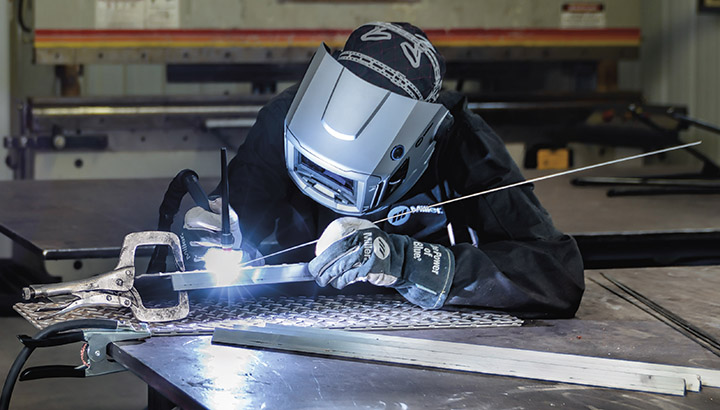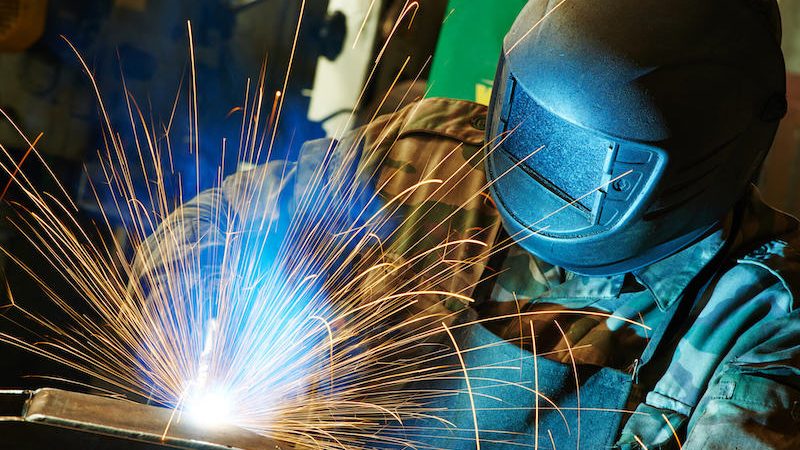Are you a welder in need of a better welding experience? Auto-darkening welding lens is the answer!
This guide will discuss the various benefits this revolutionary technology brings to welders, making it easier and safer to work. Let’s explore the fascinating capabilities of this essential tool for welders!
Auto Darkening Welding Lenses (ADLs) provide welders with enhanced safety and productivity benefits for many welding applications. ADLs are designed to automatically adapt their light-absorbing properties in order to block out the intense levels of light generated from welding equipment, typically made of protective plastic, composite or glass.
This darkening process starts almost instantaneously, giving welders nearly unlimited control over the amount of ultraviolet and infrared radiation they are exposed to during welding operations. In addition to providing improved protection, Auto Darkening Welding Lenses also allow welders to get back to work faster by eliminating the need for extra protective gear such as goggles or hoods. This reduces both time and cost associated with most welding operations, resulting in increased production efficiency.
Traditional Welding Lenses
While Auto Darkening Welding Lenses (ADLs) have many advantages and have become the lens of choice for many welders, there is still a presence of traditional welding lenses in today’s market. Traditional welding lenses are usually made of hard plastic and come with a permanent shade rating, ranging from #8 (the lightest shade) to #14 (the darkest). They provide the welder with protection from ultraviolet and infrared rays while they weld, protecting the eyes from any potential short-term or long-term harm that may be caused by the intense heat and light radiation emitted while welding.
However, unlike ADLs, traditional welding lenses require the welder to manually switch out their lenses each time they transition between different job requirements – meaning that if a welder is working on projects where the amount of protection required fluctuates constantly, then this can become cumbersome very quickly. Additionally, as traditional welding lenses do not offer an adjustable shade setting or autodarkening capabilities, this can be an issue for many welders depending on what type of work they are doing.
Explanation of traditional welding lenses and how they work
Traditional welding lenses are designed to protect welders’ eyes from the intense arc light and harmful UV radiation associated with welding processes. These lenses restrict the range of light reaching the welder’s eyes by using several shade densities of glass or plastic. When choosing a lens for their helmet, welders consider the maximum amount of time they will be exposed to arc light and select an appropriate level of darkness from either a filtered glass lens or a replaceable plastic lens.
Filtered glass lenses are difficult to replace and typically have fewer adjustments in terms of no-light state and darkness levels compared to replaceable plastic lenses. These types of lenses tend to have darker shades that block more intense magnitudes of light, like those produced in tungsten inert gas (TIG) welding processes, but this hinders visibility in lower ambient lighting conditions.
Plastic lenses come in lighter shades than glass and can be changed easily if necessary because they simply slide into place inside the hood structure. Their lightweight properties make them ideal for specific types of work environments, like outdoor arc welding where strong sunlight affects visibility levels. They also provide several adjustable settings controlling how dark they become when exposed to arc light and how soon afterward they return back to their no-light state (often referred to as reaction time).
Advantages and disadvantages of traditional welding lenses
Traditional welding lenses are manual lenses that darken when exposed to light. These lenses do provide welders with adequate protection from the arc light emitted during the welding process, however, this type of lens does have certain limitations compared to auto darkening lenses.
Advantages
-The manual nature of these lenses allows welders to customize the shade based on their needs and conditions.
-These types of lenses are less expensive than auto darkening versions and can work in areas where there is not enough power to power an auto-darkening lens.
-Manual lenses have a long battery life since they require no energy source other than natural sunlight.
Disadvantages
-Manual welding helmets are difficult to activate quickly when needed for multiple passes or on a sunny day.
-It is possible for welders using these types of helmets to miss spots unless the operators carefully monitor their eyesight.
-Without proper calibration or regular replacement, the shade of the manual lens may not match what is necessary for a particular environment or job requirements.
Auto Darkening Welding Lenses
Auto darkening welding lenses are a valuable tool that can help welders to complete the job quickly and safely. These lenses automatically adjust to the current level of brightness so that welders can work without having to continually switch lens shades, thus improving visibility and making the welding process safer. Light, infrared and UV radiation are blocked, which helps protect the eyes from potential damage. The lens also ensures that no spark is missed, ensuring a reliable weld quality every time.
In addition to improved visibility, auto-darkening welding lenses offer other advantages such as improved comfort, better performance in low light conditions and longer battery life. The adjustable shade range grants greater flexibility for a variety of welding applications. With their ergonomic design, these welding lenses are lightweight yet reliably durable for many years of use.
Explanation of auto darkening welding lenses and how they work
Auto darkening welding lenses, also known as auto-shade welding lenses, are an indispensable tool for welders who need to protect their eyes from the extreme brightness and dangerous UV rays of the arc. These state-of-the-art welding safety devices use innovative technology to offer a superior level of protection while increasing visibility and comfort.
Auto darkening lenses rely on sensors that detect the light generated by starting or maintaining the arc. When this light hits the lens, it signals a positive change in voltage that triggers a rapid mechanical reaction which causes liquid crystal molecules in the lens to shift and darken in less than one millisecond. This makes welding helmets with auto darkening lenses more responsive than traditional hard hat models which rely solely on manually adjusted shade settings.
The addition of a bright LCD display enhances visibility even further, reducing eye fatigue and improving process control during long periods of welding operations. The LCD screen also allows wearers to adjust sensitivity levels according to their preference or specific job requirements.
The increased efficiency and safety provided by auto darkening welding lenses make them invaluable for professional welders who regularly work in extreme lighting conditions such as those found in shipyards, construction sites and oil & gas facilities.
Advantages and disadvantages of auto darkening welding lenses
Auto darkening welding lenses are an important safety precaution used to protect welders from the bright light and intense heat generated by their welding torches. In addition to protecting your eyes, auto darkening lenses also help increase productivity, improve accuracy, reduce eye fatigue and radiation exposure, and provide a clearer view of the welding area. However, like any type of protective equipment, auto darkening lenses come with both advantages and disadvantages that should be carefully weighed before making a decision.
Advantages:
– Automatically darken when arc is struck – no need to lift your helmet or pause work as lens adjusts itself providing clear visibility of weld area. – Less eye fatigue compared to non-auto darkening welding lenses that require manual adjustment for light intensity & conditions. – Variable shade range allowing users to select their preferred level for different applications & conditions. – Suitable for both indoor & outdoor use even in harsh lighting environments due to its anti-glare & infrared protection capabilities. – Lightweight design makes them comfortable during extended uses over long periods of time.
Disadvantages:
– Can be more expensive than traditional non-auto darkening models due to more advanced technology used in production & design components. – Battery powered which may require occasional replacements depending on how frequently being used or stored away from power sources for extended periods of time (at least twice per year). – Not as reliable or durable as non-auto models as they may become damaged or loose calibration if dropped or mishandled during use/storage/transportation due to their intricate electronics & optical components embedded within its exterior case material fabrications (plastic/nylon fibres).
Benefits of Auto Darkening Welding Lenses
Auto darkening welding lenses have become increasingly popular among welders, with more and more welders switching to them. This is because they offer a range of advantages that can make life easier and more comfortable for welders. The most common benefits are described below:
- Instant Darkening: One of the biggest advantages of auto darkening welding lenses is how quickly it darkens from the brightest setting to its darker shading mode when exposed to light such as an arc. This allows the welder to get suited up, focus on their work quickly, and start welding in no time at all.
- Comfort & Convenience: Auto darkening lenses also provide comfort and convenience for welders who don’t need to constantly switch their lens out for a darker shade which can be taxing over long shifts with lots of welding beneath a helmet or face shield. With auto-darkening lenses, they don’t need to do this as often which ultimately leads to less fatigue and improved productivity in terms of amount of time spent actual doing the job versus changing out lens shades and/or cleaning their helmet/face shield windows.
- Protection & Versatility: Last but certainly not least there is versatility offered by many auto-darkening lens models including features such as custom settings (e.g., different work modes that provide varying levels of lens protection), enhanced vision capabilities (e.g., adjustable levels of brightness) UV/IR protection against radiant exposure, and a variety of sizes ranging from standard through extra large so you can choose what works best for your particular application or situation—all contributing to ultimate operator safety and convenience on the job site!
Improved Safety
For welders, taking the appropriate safety measures to protect themselves is essential. One of the most important pieces of safety equipment for welders are welding helmets and the lenses used in these helmets offer protection for the eyes, face and neck. The latest technologies have allowed this protection to be further enhanced by incorporating auto-darkening lenses.
Auto darkening lens technology includes a host of features that enable quick action and well-balanced protection in dynamic welding environments.
Benefits of using auto darkening lenses in welding helmets include:
- Increased Adjustability: Auto darkening lenses eliminate distractions caused by flipping or adjusting your helmet while wearing it, as they automatically adjust their shade to provide optimum darkness based on your parameters. This helps you achieve a well balanced level of eye protection from harmful arc rays along with improved visibility throughout the process.
- Accurate Detection: Auto darkening lenses can determine when an arc has been struck by monitoring changes in visible light within milliseconds allowing accurate adjustments both quickly and precisely according to preset parameters for job specific situations.
- Enhanced Protection & Quality: Features like control delay setting within the lens holds off darker shades until after arc breaks helping maintain more consistent arc illumination which enhances quality & improves accuracy. The precision & repeatability from one welding pass to another is improved as automated adjustments provide better coverage against UV & IR than traditional fixed lens helmets.
Increased Productivity
Auto darkening welding lens allows welders to increase their productivity in multiple ways. One major advantage of auto darkening welding lenses is that they remove the need for welders to constantly switch out their lens for a darker one, resulting in significant time savings. Additionally, the ability to uniformly adjust from light to dark and back allows welders to continuously focus on finishing the task while not having any glare or uncontrollable light. This in turn allows them to work faster without sacrificing safety or quality control.
Eliminating distractions and allowing better productivity is another major benefit of auto darkening welding lenses. They offer superior clarity when compared with traditional manual lenses and provide reliable protection against UV and infrared rays that can strongly effect overall visibility as well as cause eye fatigue and potential long-term damage. These lenses also reduce the risk of injury due to electric arc flashes by filtering out damaging radiation while providing shade 3-13 at a moments notice, ensuring maximum protection.
Auto darkening welding lens is an investment that will pay for itself numerous times over through increased efficiency, shorter lead times, better quality control and improved safety standards.
Better Visibility
A key benefit of an auto darkening welding lens for welders is improved visibility. Traditional lenses must be manually adjusted, which can impede the user’s vision and cause eye strain. An auto darkening welding lens has a liquid crystal sensor that adjusts darkness automatically, optimizing visibility of the work-piece even in different light levels. The shade is dark enough to protect the welder from harmful sparks, but still light enough to provide a clear view of welding seams. This means welders get better and more precise control over their work, leading to higher quality results.
Additionally, an auto darkening lens protects the eyes from ultraviolet rays, further reducing the chances of eye strain or injury while on the job.
Enhanced Comfort
Working with an auto darkening welding lens improves comfort for welders by eliminating the need to continually switch between welding and safety masks. The lens automatically adjusts to the correct shade every time it is activated, meaning no more waiting for the darkening reaction or hassling with multiple filters.
Additionally, this allows welders to approach exact tolerances more precisely while working in a consistent environment they can trust. Auto darkening lenses also provide protection from flashes and reflections that can cause eye strain and fatigue when leaving workers unprotected while they’re focused on their job.
Conclusion
Auto Darkening Welding Lens (ADL) technology is a great way to ensure maximum safety and efficiency while welding. ADLs help ensure welders receive optimum protection from damaging UV and IR radiation, as well as providing better visibility and comfort while working in intense heat. ADLs can be used on a variety of welding machines, including MIG/MAG, TIG welding machinery and welders.
With the onset of arc sensors that detect the optimal shade of lens to use at any given moment, auto-darkening technology provides an unprecedented level of convenience to welders.
Welder safety should always come first when considering a particular type of welding equipment or practice. Auto Darkening Welding Lens technology provides welders with optimal protection from UV and IR radiation emitted during their project work, allowing them to enjoy a more efficient workspace with greater visibility and comfort. The advantages offered by ADLs greatly outweigh the cost associated with purchasing them for any workplace’s welding needs—investing in auto-darkening technology will help maintain the health and longevity of any dedicated welder.
FAQ’S
What are the benefits of welding helmet?
Welding helmets provide protection to the welder’s face, head, and eyes from sparks, heat, and radiation. They also help in preventing eye fatigue, arc eye, and long-term eye damage.
Why is it necessary to wear welding helmet with dark lens while welding?
Welding produces intense light and radiation, which can cause eye damage, including blindness. Dark lenses in welding helmets filter out harmful ultraviolet and infrared radiation and prevent eye injury.
Do professional welders use auto-darkening helmets?
Yes, most professional welders use auto-darkening welding helmets. They provide convenience, efficiency, and improved safety compared to traditional welding helmets.
Do auto-darkening welding glasses work?
Yes, auto-darkening welding glasses work by automatically adjusting their shade level in response to the welding arc’s brightness. They provide protection to the eyes and are convenient to use.
What are the advantages of auto-darkening welding helmets?
Auto-darkening welding helmets provide fast and automatic adjustment of the lens shade level, which reduces eye strain and fatigue. They also allow welders to see clearly before and after welding without removing the helmet.
What are two advantages of self darkening welding helmet?
Self-darkening welding helmets provide better visibility, improved safety, and convenience to welders. They eliminate the need for manual adjustments, thus reducing eye fatigue.
What are the benefits of welders?
Welders play an essential role in construction, manufacturing, and other industries. They create and repair metal structures, machines, and equipment. Welders can also specialize in specific welding techniques and materials.
What are the benefits of welding goggles?
Welding goggles provide protection to the eyes from sparks, debris, and radiation. They also allow welders to have a better view of the welding area, which improves accuracy and efficiency.
How do welders protect their eyes?
Welders protect their eyes by wearing welding helmets or goggles with dark lenses. They also wear protective clothing, such as gloves, aprons, and jackets, to protect their skin from burns and cuts.
How do you prevent blindness in welding?
Blindness in welding can be prevented by using proper eye protection, such as welding helmets or goggles with dark lenses. Welders should also take frequent breaks to rest their eyes and avoid looking directly at the welding arc. Regular eye exams are also recommended to detect any eye damage early.
See more :
- Best tig welding gloves 2023
- Best welding boots 2023
- Best welding caps 2023
- Best welding cart 2023
- Best welding gloves 2023


